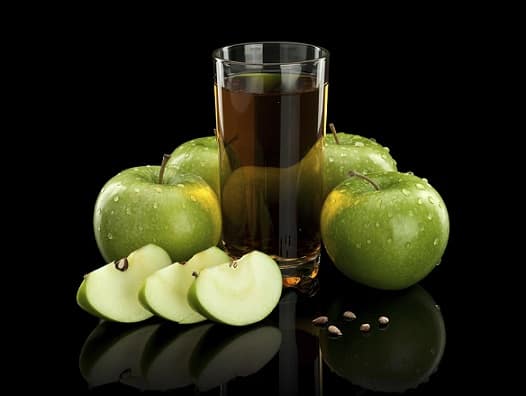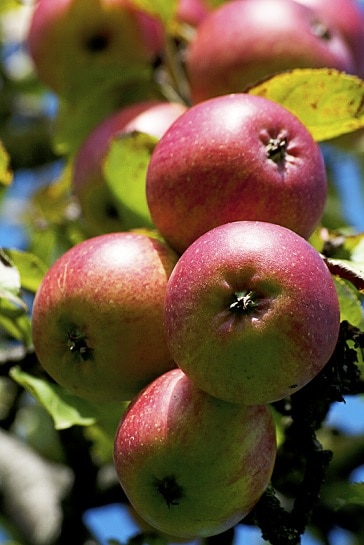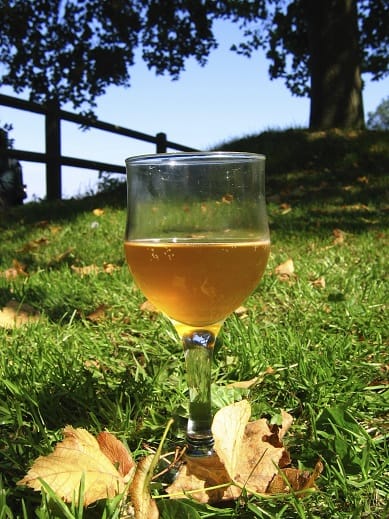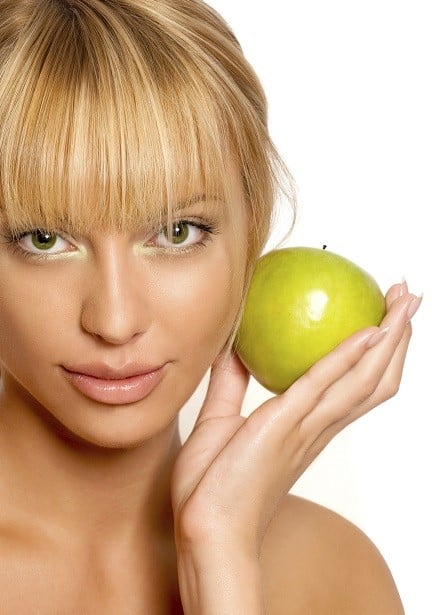Here at Supernatural Acne Treatment, we’ve made it our mission to analyse the acne-clearing (or maybe acne-causing) powers of many common fruits in detail, and now, it’s time to discuss apples.
They’ve long had the reputation of a nutritious superfood, not least because of the famous “apple a day” proverb. This reportedly originated from Pembrokeshire in Wales, where the original saying was “eat an apple on going to bed, and you’ll keep the doctor from earning his bread”.
By the early 20th century it had evolved into “an apple a day, no doctor to pay”, and by 1922, it had taken its modern form of “an apple a day keeps the doctor away”, the year the phrase was first recorded.
If the proverb applies to acne as well, then that’s excellent news, as apples are the second most popular fruit in the USA. The average American eats 19 pounds per year, ranking behind only the banana at 33 pounds.
The good news is that while researching this article, I discovered that apples are far more acne-friendly than I once believed.
Bursting with acne-clearing antioxidants
 At first glance, apples look rather basic with little acne-clearing nutrition to offer. A single apple weighing 150 grams contains…
At first glance, apples look rather basic with little acne-clearing nutrition to offer. A single apple weighing 150 grams contains…
- 12% of the recommended daily intake (RDI) for vitamin C.
- 5% of the RDI for potassium.
- 0% of the RDI for vitamin B12.
- 5% for vitamin K1.
- 3% for manganese.
- 2% for vitamin A.
- 3% for vitamin B6.
- 1% for vitamin E.
- 2% for calcium and magnesium.
The apple’s standout is clearly its vitamin C, which clears acne by lowering stress hormone and accelerating collagen formation, but even this is fairly poor compared to pineapple (79% of the RDI), strawberries (97%), and oranges (88%), Like the pomegranate however, the real star of the apple show is its vast range of acne-clearing antioxidants.
You see, apples score nearly as highly on the ORAC scale for measuring antioxidants as the endlessly praised blueberry. 100 grams of raw blueberries scores 4669 while a raw red delicious apple with the skin scores 4275, and a raw Granny Smith apple scores 3898. Studies everywhere affirm that apples are bursting with antioxidants:
Read Annihilate Your Acne – get the greatest diet ever for clear and radiant skin
ONE – 25 healthy patients drank apple juice for two weeks, with their blood antioxidant levels being measured before and after (study). The scientists concluded that “intake of apple juice was efficient in enhancing the body’s antioxidant status“, and that’s only the apple juice. A whole apple retains far more of its natural enzymes and compounds because it has all of the undamaged fibre.
TWO – 4 women and 1 man were given an apple and blackcurrant juice (not squash) by scientists, and after 1 week, a powerful bodily antioxidant called glutathione peroxidase rose sharply, in close correlation with the juice dosage. Markers of oxidative stress such as malondialdehyde and lipid peroxides fell sharply (study).
THREE – some rats on a high cholesterol diet were given either peaches, apples or pears in a 2002 study. While all three boosted plasma antioxidant capacity, apples came out on top. Apples scored highly on the total radical-trapping antioxidative potential (TRAP) scale, and were richer in three individual antioxidant called ferulic, caffeic and p-coumaric acid (more on them later).
Apples are a tasty bombshell of antioxidants and for acne, this means that apples can prevent clogged pores, as antioxidants are vital for lowering squalene peroxide (see here). Antioxidants are also the key to switching a dull and grey skin tone into one that’s bursting with life.
We also understand the reason, as apparently, the white flesh inside apples is particularly vulnerable to sunlight. The radiation can damage the photosynthesising cells necessary for the fruit’s survival, and consequently, the apple creates a natural sunscreen of polyphenols, one of the fruit’s main antioxidants, which can actually absorb UVB radiation wavelengths. These antioxidants remain in place when the apple is picked from a tree and dropped on your plate, all ready to eat.
Next: the 6 vitamins and minerals which can massively reduce acne
In fact, it’s estimated that 100 grams of raw apple has a total antioxidant activity equivalent to 1500mg (2500% of the RDI) of vitamin C. Apples are particularly high in free phenolic antioxidants, which aren’t bound up with other compounds and are therefore absorbed into the bloodstream highly efficiently.
The 3 skin-clearing compounds of apples
What’s even better is that the specific antioxidants in apples have their own special powers:
Quercetin – in this article about sweet potatoes, we discussed how a phytonutrient called quercetin can prevent allergic acne by calming down immune system actors in the gut called mast cells. This progresses to improved acne nutrient absorption and a stronger balance of gut bacteria, and luckily for us, apples are another strong source of this compound. Quercetin can also slash inflammation, as studies show strong reductions in the inflammatory biomarker C-reactive protein.
Chlorogenic acid – this antioxidant is responsible for the wildly hyped weight loss and heart protecting powers of coffee, and luckily for us, lowering inflammation is partly how it works.
This 2014 study found sizeable reductions in a swathe of pro-inflammatory chemicals, including interleukin-6, IL-1beta, and COX-2. In the the human body, chlorogenic acid is metabolised into the structurally related caffeic acid, which has strong anti-inflammatory powers of its own (study).
The 7 greatest topical treatments for naturally clear skin
Chlorogenic acid is far rarer than the aforementioned quercetin, but apples are an excellent source.
Ferulic acid – a compound found in bilberries, dates, coffee and certain beans, which has similar anti-inflammatory properties to chlorogenic acid, but also improves the efficiency of insulin molecules according to one study. That’s excellent news for acne because its means that less insulin is necessary in the bloodstream overall (insulin is the worst hormone for oily skin). The scientists mentioned that ferulic acid has prospective benefits for type 2 diabetes, which is intrinsically linked to skyrocketing insulin.
There’s probably more compounds in apples which scientists haven’t identified yet. While apples don’t quite hit the acne-clearing height of pomegranates or strawberries, they have plenty of raw nutritional strength, strength which cannot be deduced from a quick vitamin C count on a google nutrition table.
Why apples can occasionally destroy your skin
With the praise now done and dusted, apples are nowhere near perfect for acne. Their biggest flaw is by far their high amounts of FODMAPs, a completely natural villain, a wide family of carbohydrates which many modern humans can barely digest.
FODMAPs are rapidly digested by unhealthy intestinal bacteria and have a strong tendency to suck in water. This causes symptoms like gas, bloating, stomach pain, indigestion – and our old friend acne.
FODMAPs are the answer to an old riddle – why many seemingly healthy and “clean” foods can give people explosive acne outbreaks with no logical explanation. They’re why blackberries might mysteriously be your nemesis while the rest of the nutritional world is bowing down before them.
Why bread and pasta are a massive cause of acne
We’re not going to get into the full causes of FODMAP sensitivity here, except that genetics and antibiotic abuse are two of them. You could write an entire book about FODMAPs, but what’s certain is that apples are a classic FODMAP sensitivity food. They’re a classic food for unexplained reactions like acne, as the internet is littered with people complaining of cysts, a whole new family of pimples, and uncomfortable indigestion after eating just one.
Supposedly, 5% of the population has an apple allergy. Doctors agree, as when prescribing FODMAP avoidance diets, apples (along with mangoes, peaches, watermelon, blackberries, figs, and apricots) are always in the no-go section.
There are two specific FODMAPs in apples. Firstly, its ratio of total sugars is skewed way towards the poorly digested fructose rather than glucose. Its ratio is 2:1 (67% fructose) versus a far healthier 0.2:1 for cranberries (17%). This fructose makes up the M for monosaccharide portion of the acronym.
Secondly, every apple you hold is packed with sorbitol, a member of the “P” for polyol portion. Sorbitol is a popular sugar-free sweetener in baking, proudly bearing the shiny E-number of E470, but it’s also the main FODMAP of many sweet fruits like peaches and blackberries. Meanwhile, root vegetables such as onions have fructans as their main FODMAP (an “O” for oligosaccharide).
The entire issue of FODMAP sensitivity can actually be solved with a months-long protocol requiring much patience. No FODMAP food is inherently toxic – you just need to strengthen your gut bacteria to digest them correctly.
The point for now is that because of FODMAPS, acne patients can and do have bad reactions to apples. You’re probably safe, but be prepared!
The truth about sugar in apples
 The second crack in the apple’s acne-clearing armour is its relatively high sugar content. It depends on the agricultural strain, but a medium sized apple (weighing 150 grams) carries between 10 and 15 grams of sugar, while the same quantity of raspberries or strawberries boasts just 7-8 grams.
The second crack in the apple’s acne-clearing armour is its relatively high sugar content. It depends on the agricultural strain, but a medium sized apple (weighing 150 grams) carries between 10 and 15 grams of sugar, while the same quantity of raspberries or strawberries boasts just 7-8 grams.
Sugar, of course, is an inflammatory menace which is secretly wielding the puppet strings of many of today’s health epidemics. However, its consequences rarely kick in at below 50 grams daily. Eating some sugar is unavoidable, lest you drive yourself mad with an all meat and oil diet.
Consequently, a moderately sugary apple won’t derail your acne-clearing campaign whatsoever. You just need to avoid gorging on mountains of sugary chocolate and candy elsewhere. It’s also smart to restrain your overall fruit consumption to 3 servings per day, with one high and one low sugar slot, and your apple fitting neatly into the moderate slot.
Indirect evidence of acne greatness
Moreover, it’s obvious from the anecdotal evidence that the two problems above barely dent the apple’s acne benefits. The old proverb didn’t appear out of thin air – apples have been referenced in folklore tales handed down throughout history, and these days, science is stepping in.
Stroke prevention – in a large study on 70,000 people, apples and pears had the biggest preventative effect on strokes. Many fruits and vegetables were tested, and leafy green vegetables also performed well.
Cancer prevention – many studies have detected an unusual ability in apples to prevent colon and lung cancer, and its flavonoid antioxidants have anti-proliferative effects on isolated cancer cells. One apple a day is enough is enough slash your cancer risk (so it’s true!).
Type 2 diabetes – we already discussed how ferulic acid can prevent insulin resistance, the genesis of type 2 diabetes. One excellent study found a 7% reduced risk of diabetes from eating whole apples, and various apple compounds can 1) stimulate the absorption of glucose in the digestive tract, and 2) enhance the sensitivity of insulin receptors.
Vitamin D – the greatest nutrient for a bright and glowing skin tone
Weight loss – eating a whole apple before a meal may reduce your calorie intake by 15%, while strengthening your feelings of post meal satiety (2009 study). Note that only a whole apple achieved these results, rather than apple juice or apple sauce.
The sheer variety of the apple’s health benefits is excellent news for us clear skin maniacs, because acne is merely a symptom of a wider problem in the body.
Your skin’s appearance is intricately linked to health conditions of all kinds, whether it’s blood sugar, gut health, nutrient intake, or even cognitive issues (with inflammation being common to both).
The verdict – should acne patients feast on apples?
After sifting through all the evidence, my conclusion is as follows: apples are not an extraordinary superfood. They’ve very run of the mill for an acne-clearing fruit.
They can’t compare to watermelons with their power to accelerate wound healing, or cherries and their sleep boosting powers. Nevertheless, apples are excellent for acne-clearing antioxidants and their anti-inflammatory properties are very respectable.
Consequently, they’re a top food to eat as part of a wider acne-friendly diet. If you adore the taste of apples or are eating them already for your wider health, then keep going!
Apples are perfect for circumstances where your antioxidant demands are high; if you’re a smoker, if you’re bombarded by free radicals from air pollution, if you’re dependant on fast food cooked in vegetable oils, or if you’re a labourer in factories or fields where pesticides are floating around.
Overall, apples sit firmly in the middle of the acne-clearing fruit pack. They’re inferior to pomegranates, berries, watermelons and citrus fruits, but they’re superior to pears, green grapes, peaches, and apricots. Apples are about equal to bananas in raw acne-clearing power.
One last important note: eating the skin of an apple is absolutely vital.
The skin is where all the antioxidant defences are concentrated, which is why the skin is a vibrant red or green colour whereas the flesh inside is a yellowy white. Antioxidants provide colour in fruits (think pomegranate). For example…
- A raw apple with the skin features 4.42mg of quercetin whereas a raw red apple without features 1.50mg.
- A raw red delicious apple has an ORAC score of 4225, whereas a raw skinless red delicious has a score of just 2936.
- The phenolic compounds are particularly concentrated in the skin, which provides the apple’s every-varying red colour constellations.
Never, ever peel the skin off! It’s also a smart idea to pick the most colourful apples you can find.
Say no to apple juice!
 Don’t get the idea that you can simply swig down a carton of apple juice for breakfast. The whole fruit and its juice are completely different beasts, especially for acne patients.
Don’t get the idea that you can simply swig down a carton of apple juice for breakfast. The whole fruit and its juice are completely different beasts, especially for acne patients.
Firstly, like any fruit, apple juice is dramatically higher in sugar, climbing to 25 grams per single cup. Unlike in a whole apple, where’s there’s plenty of soluble fiber and apple pectin to bind the sugar together, the sugar in apple juice is digested in a millisecond, where it floods straight to your liver, transforms into fat, and plays havoc with your insulin levels.
As a rule, the inflammatory dangers of sugar are enhanced by rapid digestion, and this includes any sweet liquid, whether it be orange juice or cans of fizzy drinks. In fact, the fruit juice marked to children as “healthy” or “one of your five a day” is equally responsible for the epidemic of rotting teeth in youngsters as chocolate cookie or cake.
The second reason to minimise apple juice, meanwhile, is its sky-high levels of arsenic contamination.
Arsenic is a heavy metal which was once popular as a pesticide, but was banned in the early 2000s due to its skin-discolouring, intestine-wrecking, and brain-frying qualities. The Environmental Protection Agency (EPA) limited the quantity of trace arsenic allowable in drinking water to 10ppb, but strangely, the EPA didn’t take action on foods and other popular drinks…
…and hence, a test by Consumer Reports on 88 juice samples found that 10% had arsenic levels higher than the US federal drinking water limit. A quarter also had lead levels high than the 5pbb limit for bottled water.
Apple and grape juices are the most contaminated juices of all, beating orange juice by a country mile. 8 samples of apple juice, for instance, had arsenic levels of 23ppb of more. Separately, Consumer Reports studied nutritional data on 3000 people from 2003 to 2008, and noticed a 19% increase in urinary arsenic levels in people who drank apple juice regularly compared to participants who didn’t.
Why’s that a problem for acne specifically? Because somehow, arsenic has the power to accelerate your keratin production.
Keratin is the protein that binds your skin cells together. It is utterly critical for acne patients to control because when there’s too much keratin being produced, your dead skin cells bind together too, after which they mix with sebum (oil) and turn into an immovable pore-blocking glue.
Green tea – proven to reduce acne by up to 51% after 8 weeks
Another classic symptom of arsenic poisoning is skin discolouration, and a particularly notorious consequence is vitamin A deficiency. Night blindness is a common symptom, for example.
The good news is that in 2013, the FDA responded to a wave of publicity and proposed hard limits on arsenic in apple juice.
There was also a big public outcry, led by television guru Dr Oz after he did an exposé on his popular show. Logically, apple juice companies are bound to cave to both government and consumer pressure and clean up their products soon.
Until that shining day comes though, steer clear of apple juice and eat the whole fruit instead. Besides, arsenic or not, all fruit juice is too high in acne-causing sugar by its very nature.
Personally, I love apple juice and used to have a glass every day with my breakfast. However, it clearly caused a painful burst of acne to sprout up on my cheek nearly every time I drank it. It was always one of my peskiest breakout foods, and hence, I now only drink it as a special treat when dining out a restaurant.
NEXT: the ultimate diet for clearing acne permanently
Thanks for reading!

I have been eating “clean” for the past 2 months it is helping but not 100% yet. But the thing is i am in high school and if I want to eat clean I have to cook a meal in the morning. ( like Sweet potatoes with chicken breast , brocolli , brown rice , eggs and some fruit like kiwis , strawberries etc) But I cant eat bread anymore because gluten = breakouts right. So I only take fruits to school like apples and bananas. I have been succeeding doing this but most days I am starving and it takes away my concentration. Now thats a real dillemma because acne also makes me depressed but now it also makes me kinda feel bad not being able to eat throughout the day at school before I am at home. Please give me advice .. :(
I’d stick with the bananas and apples, and add a filling acne-friendly food in as well. Your tasty solution = 85% dark chocolate. Nuts like almonds are optimal as well unless your skin has a sensitivity to them (test it and see). Allocate all your portable food to the middle of your school day and reserve all the cooked food for later. Dark chocolate is great for concentration as well since it contains the stimulant theobromine, which is structurally related to caffeine. Also, if you’ve discovered this acne knowledge while still at high school, well done – you’re ahead of the game.